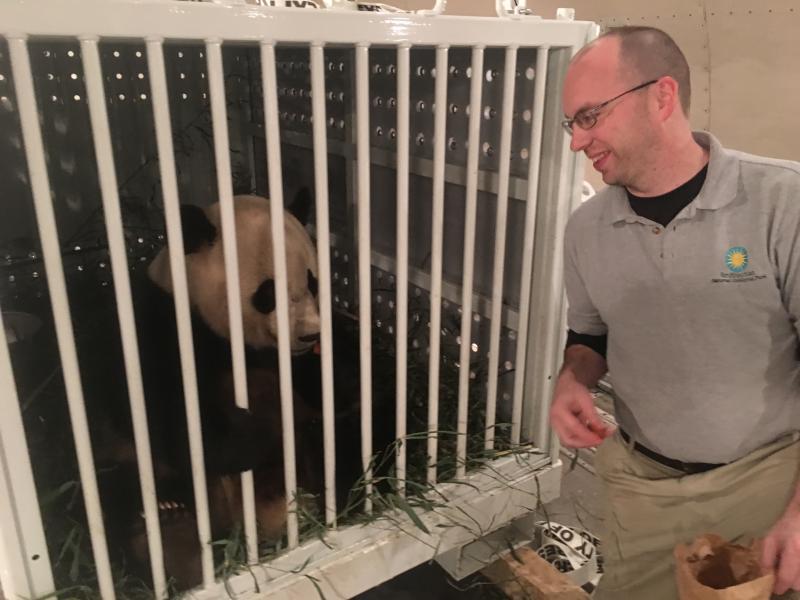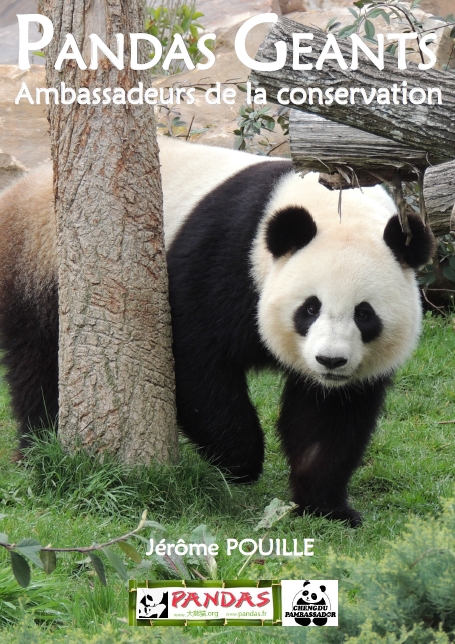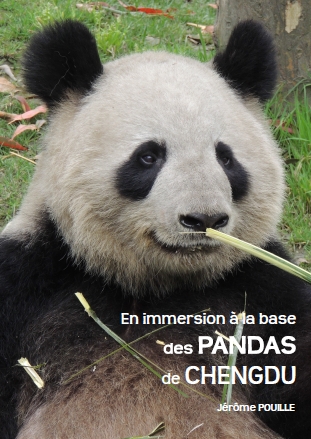Communiqués des zoos > Washington (USA)
Giant panda cub weaning FAQ
Date : 15 mars 2017 | Auteur : National zoological park | Source : Zoo de Washington
The Smithsonian's National Zoo has received good questions about the giant panda weaning process and recent behaviors exhibited by Bei Bei and Mei Xiang. The giant panda science and animal care team put together this FAQ, which includes further context on maternal/cub and pre-estrus behaviors and the history of the giant pandas in the Zoo's care.
When do you wean panda cubs from their mothers at the Smithsonian's National Zoo?
At the Zoo, we wean panda cubs around 18 months of age which has proven successful for the three zoos in the United States who have raised multiple panda cubs.
Why can’t mothers and cubs live together permanently?
Pandas are solitary animals, they do not live in groups. Mothers and cubs do not stay together in the wild. If we were to keep them together much beyond the point when a cub is self-sufficient, that would eventually cause aggression.
What behaviors indicate it is time for a cub to wean from its mother?
The biggest indicator for the cub to separate from its mother is when the cub becomes less dependent on its mother. At that point, the cub is meeting his/her nutritional needs through the consumption of bamboo and other solid foods. Additionally, a cub and mother will spend longer periods of time apart in separate areas of the enclosure.
What are the lessons learned in weaning Bao Bao and Tai Shan that impacted Bei Bei’s weaning process?
We learned that the ambiguity of a drawn-out separation can actually make things more stressful. Once a cub is comfortable and confident in a new yard, it is best to give them independence. There is a period of adjustment, but a clean quick separation is the easiest way for both mother and cub to adjust.
When Mei Xiang and her cub(s) begin living independently, is it stressful for them?
In the wild a cub would move further away from its mother, where it is unable to hear or see her. At the Zoo, we cannot completely mimic the exact conditions. As a result, the first week of weaning may be stressful as the cub and mother adjust to being near to each other, but separated. During the first week of Mei Xiang and Bei Bei living apart, we heard them vocalizing to each other which sometimes agitated them. We also witnessed some restless pacing and climbing which has since abated. During this time, we tried to ease the stress by giving them extra keeper attention.
What do you do for Mei Xiang and her cub(s) to ease the weaning process? How do you respond when you see or hear a behavior that is in response to the separation?
If we see that either panda is agitated, keepers try to calm them either by giving them favorite enrichment items—such as honey on crates and fruitsicles—or engaging in an interaction, like a short training session.
In fact, keepers interact with Bei Bei at least three additional times per day. He is comforted just by seeing his keepers, or by keepers talking to him.
Mei Xiang is more likely to ignore keepers’ efforts to engage her as she is starting to experience hormonal changes as the breeding season gets closer. Additionally, Tian Tian, who lives in the enclosure directly next to hers is in rut and is often vocalizing to her, which can sometimes elicit animated responses from her—all perfectly normal.
What happens to a female after a cub weans?
The female will start cycling again and will go into estrus 40 to 60 days after weaning. Mei Xiang is already showing signs of pre estrus (restlessness, water play, scent-anointing). For pandas, reproduction ends around 20 years old. Mei Xiang is near the end of her reproductive life cycle. However, it is important for the global population of giant pandas that her genes are represented and she has the opportunity to breed again this year.
What’s the difference between a pre-estrus behavior directed towards Tian Tian and a response to Bei Bei?
Mei Xiang’s location and vocalizations are good indicators of whether she is exhibiting a pre-estrus behavior or a response to Bei Bei. A response to Bei Bei would focus on the back wall closest to his enclosures. Her vocalizations are usually high-pitched short chirps. When she responds to Tian Tian, she makes a moaning vocalization at him usually through one of the ‘howdy’ windows between their yards. If she is responding to rut behaviors from Tian Tian, she paces inside her indoor enclosure and outside throughout her yard.
It seems like Bei Bei is less active since weaning and living independently from Mei Xiang. Is that normal?
We witness many of the same behaviors and activity patterns with Bei Bei as we saw before the separation. The one exception is social play, as he does not have access to another panda. He is eating, exploring his yard, and playing and interacting with enrichment. He found a tree that he likes to sleep in and he naps in it regularly both in the morning and afternoon, much like he did while he was still with Mei Xiang.
Why is Bei Bei sometimes climbing a tree near Mei Xiang’s enclosure?
Bei Bei identified a new favorite “napping” tree in his yard that will hold his weight and is close to Mei Xiang’s enclosure. He can see the keepers as well as other parts of the panda habitat when he is in that tree and often climbs it when he hears the keepers in the area.
Bei Bei is spending a lot of time at the fence. Why?
Since the fence is solid, he is not able to see/interact with the keepers like he did when he was in Mei Xiang’s yard. In her yard there is mesh at the back that permits visual access to keepers while they are working. The back corner of Bei Bei’s yard is the closest area to the keepers when they are working near the bamboo shed. Bao Bao also spent time in that corner, especially when she wanted more food or to interact with keepers.
Is the Zoo or the panda team giving Mei Xiang or Bei Bei any type of medication or supplement(s) to control behavior or to impact the breeding process?
Outside of routine vaccinations and deworming drugs (to keep them healthy), the giant pandas do not receive any other medications.
Communiqués des zoos > Washington (USA)
Bao Bao is settling into her new home
Date : 9 mars 2017 | Auteur : National zoological park | Source : Zoo de Washington
This update was written by keeper Marty Dearie.
Bao Bao is settling in China at the Dujiangyan panda base. Our 16-hour direct flight aboard the FedEx Panda Express was smooth and Bao Bao did really well. She ate and slept the entire way to Chengdu, just as we expected. All the weeks of acclimating her to her travel crate paid off.
Upon arrival at the Dujiangyan panda base, Bao Bao walked into her new enclosure within one minute of when her new keeper opened her travel crate door. She immediately starting exploring and was very relaxed. I stayed at Dujiangyan for three days, in case there were any questions about her, or if it seemed like she needed a familiar keeper. True to her character, Bao Bao was very independent and began taking food from her new keeper immediately. Her diet in China will be similar to what she ate at the Smithsonian’s National Zoo. She has more variety of bamboo to eat, and she started eating it right away. She surprised me when she ate a carrot offered by her keeper—carrots were always one of the diet items she was less enthusiastic about when she lived at our Zoo. She didn’t choose to eat the specially-made panda bread, but she will likely acquire a taste for it with time. It’s more important that she eat bamboo than the panda bread.
Bao Bao also participated in training sessions and performed behaviors that we taught her over the last few years without missing a beat. Our Chinese colleagues use very similar, or the same body gestures, to communicate to pandas what we need them to do. Bao Bao picked up on all the hand signals and body gestures paired with verbal cues in Chinese very quickly. By the time I left, Bao Bao preferred to interact with her new keeper, which is what I was hoping would happen. She quickly realized that he would be feeding her and began responding to him. At the time of my departure, Bao Bao seemed very comfortable. Hopefully, in a few years our colleagues in China will share happy news with us that Bao Bao has become a mom.
Several of our scientists from the Smithsonian Conservation Biology Institute and our chief veterinarian were in China shortly after I left Dujiangyan. They happened to see Bao Bao while they were there and took some photos of her enjoying bamboo shoots in her new yard.
Back at the Zoo, we are in the early stages of Bei Bei’s life as an independent bear. Just as we observed with previous cubs after the first week of living apart, Mei Xiang and Bei Bei have begun to settle into their new independent routines. They both spend less time wandering and vocalizing to each other, which is not unusual behavior for a mother and cub during the transition. Bei Bei has acclimated to his new yard and indoor enclosure. He is spending the same amount of time eating, sleeping and engaging with enrichment as he did before living separately. We’ll continue to monitor both bears and provide support and individual attention as necessary through this transition. Mei Xiang has been displaying some pre-estrus behaviors over the last several days, including wandering, water play and she was caught on the panda cams scent-anointing herself yesterday.
Communiqués des zoos > Washington (USA)
Bei Bei is weaning
Date : 4 mars 2017 | Auteur : National zoological park | Source : Zoo de Washington
People who have been watching the panda cams have seen some big changes over the last few weeks. Bei Bei is weaning from Mei Xiang. We have heard from many worried panda fans as Mei Xiang and Bei Bei go through their weaning process. This is the third panda cub we have weaned at the Smithsonian’s National Zoo. We are monitoring Mei Xiang and Bei Bei’s behaviors closely. Pandas are solitary animals, and cubs generally separate from their mothers around 18 months old. This is a natural process. Bei Bei is a resilient bear who is learning to be independent, and the animal care team is supporting his efforts. This is a process, but there is professional and dedicated staff monitoring our pandas and attending to their needs. The animal keepers provide all our pandas with lots of attention, including training sessions and enrichment, timed throughout the day.
Just like with any new big adjustment, there have been some stressful moments, but Bei Bei and Mei Xiang are adjusting. The timeline for Bei Bei’s weaning mirrored Bao Bao’s, which is the same model other institutions have successfully used with their cubs. The ambiguity of drawn-out separation can actually make things more stressful for moms and cubs. A clean, quick separation has proven to be the easiest way for both individuals to adjust. Prolonging the process (repeatedly letting them spend time together, then separating them) doesn’t eliminate any anxious behaviors; it just draws them out.
Even though Bei Bei is living separately from Mei Xiang, and has always lived separately from Tian Tian, he is still very aware of both of them. Yard 3 (the yard he lives in now) offers some good viewing opportunities to yard 2 (Mei Xiang’s yard), and just like his older siblings before him, Bei Bei is making use of them. All of our pandas are aware of what the others are doing—they live in close proximity, and can see, hear and smell each other. Bei Bei is likely sometimes trying to climb to see Mei Xiang. It is ok, because we know from our own experiences with his older siblings, as well as from the other zoos that have weaned pandas, that this disruption is short-lived, and that all will be fine soon. Bei Bei is already adjusting, and has been exploring and making use of the features of his new enclosures, such as napping in his indoor hammock.
We are already seeing behaviors in Tian Tian and Mei Xiang that show they are preparing for the upcoming breeding season. Mei Xiang has been pacing, which may be related to weaning Bei Bei, but it is also a common pre-estrus behavior. In conjunction with the pacing, we heard her vocalizing to Tian Tian on Friday. Again, we can’t speculate what her motive is, but it seems she is reacting to Tian Tian at least as much as she is to Bei Bei recently. These are same behaviors we saw with her previous two cubs, and past experiences have shown us that the disruption is short lived.
For 45 years, our passionate and professional animal care staff and scientists have worked to care for, study and help save this charismatic species. Our work would not be possible without your support. Thank you for reaching out with your questions on Mei Xiang and Bei Bei!
Communiqués des zoos > Washington (USA)
Bao Bao arrives in China
Date : 22 février 2017 | Auteur : National zoological park | Source : Zoo de Washington
Bao Bao, her keeper Marty Dearie and Dr. Katharine Hope landed at China’s Chengdu Shuangliu International Airport around 6:59 p.m. CST after a 16-hour direct flight aboard the “FedEx Panda Express,” a custom-decaled 777F aircraft. Bao Bao ate, drank and slept normally during the smooth flight.
“Bao Bao was a real champion during the flight. All the weeks of training and preparation served her really well,” said Marty. “She’s in excellent hands now and I’m glad I get to transition with our Chinese partners and have my ‘goodbye’ in a couple days.”
Upon arrival in Chengdu, Bao Bao’s new keepers from the China Conservation and Research Center for the Giant Panda drove her to Dujiangyan Panda Base where she will stay in quarantine for approximately 30 days. Marty will remain with Bao Bao for three days while she acclimates to her new home. It is not confirmed if Bao Bao will remain at Dujiangyan after the quarantine period has ended. She will enter the giant panda breeding program when she reaches sexual maturity between 5 and 6 years old.
Back in Washington, D.C. at the Zoo, the panda team is looking to the future. Bei Bei is already a year-and-a-half old! Giant panda cubs usually separate from their mothers around 18 months old, and Bei Bei is becoming more independent and confident every day. He is fully recovered from his emergency surgery this winter and is growing like a weed. Several months ago, we started seeing the first signs that Mei Xiang was preparing to wean him. She is much less accommodating for nursing sessions, which is normal because Bei Bei has not been nutritionally dependent on Mei Xiang for several months. Any nursing sessions he has are for comfort rather than food. He is 131 pounds now (much larger than Bao Bao was when she weaned from Mei Xiang) and eats nearly 90 pounds of bamboo (along with Mei Xiang) per day, 1/3 pound of apples, 1 pound of biscuits, and a little more than half of a pound of sweet potatoes every day.
Earlier today, keepers gave Mei Xiang and Bei Bei their first opportunity to spend time together in Yard 3, Bao Bao’s old yard. If Bei Bei becomes familiar with this yard while he is still living with Mei Xiang, then his transition to living on his own will be much smoother. Everything went well this morning.
Tian Tian also got a change of scenery today! He has access to both his regular yard and Mei Xiang’s yard which made him a very happy panda. He investigated all of Mei Xiang’s scent marks and did lots of scent-anointing (rubbing her scent all over his head). He appeared to be in a very playful mood acting more like a cub than a 19-year-old bear. He tumbled around the yard and even climbed a few trees!
Communiqués des zoos > Washington (USA)
Giant panda Bao Bao arrives safely in China
Date : 22 février 2017 | Auteur : National zoological park | Source : Zoo de Washington
Giant panda Bao Bao and Zoo staff landed at China’s Chengdu Shuangliu International Airport around 6:59 p.m. CST. Aboard the “FedEx Panda Express,” a custom-decaled 777F aircraft, Bao Bao’s non-stop 16-hour flight departed Feb. 21, at 1:55 p.m. EST from Dulles International Airport in northern Virginia.
“Bao Bao was a real champion during the flight. All the weeks of training and preparation served her really well,” said Marty Dearie, “She’s in excellent hands now and I’m glad I get to transition with our Chinese partners and have my ‘goodbye’ in a couple days.”
Upon arrival in Chengdu, Bao Bao’s new keepers from China Conservation and Research Center for the Giant Panda drove her to Dujiangyan Panda Base where she will stay in quarantine for approximately 30 days. Keeper Marty Dearie will remain with Bao Bao for three days while she acclimates to her new home. It is not confirmed if Bao Bao will remain at Dujiangyan after the quarantine period has ended. Bao Bao will enter the giant panda breeding program when she reaches sexual maturity between 5 and 6 years old.





